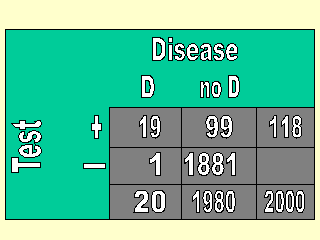 |
For example if the test is used in screening
people indiscriminately (e.g. in a shopping mall) unless the only people who want to be
tested are the people who know they have the disease and want an update or who have a
positive family history or some factor making them likely to have the disease, then the
prevalence will be low – say 1%. If so, then you will get the results as shown if the
sensitivity and specificity are both 95%. Twenty people will have the disease out of the
2000 tested (1%) and of these 19 will test positive and 1 will test negative. One thousand
Nine Hundred Eighty people (1980) don’t have the disease but only 95% will test
negative and so 99 will test positive. One Hundred Eighteen (118) people (19+99) will have
positive tests but only 19 have the disease (16%). The other 84% have false positive
results from the test. The predictive value of a negative test is however almost 100%.
|
